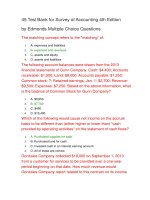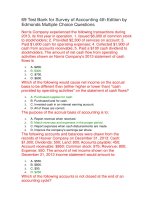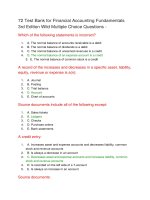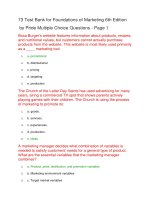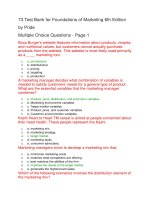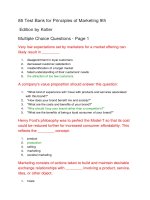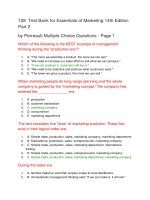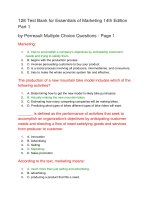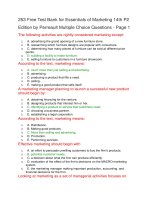118 test bank for foundations of marketing 4th edition đề trắc nghiệm marketing
Bạn đang xem bản rút gọn của tài liệu. Xem và tải ngay bản đầy đủ của tài liệu tại đây (138.67 KB, 23 trang )
118 Test Bank for Foundations of Marketing 4th Edition
Mutiple Choice Questions - Page 1
Marketing is the process of
1.
2.
3.
4.
5.
A) promoting products through personal selling and advertising to facilitate
satisfying exchange relationships.
B) creating, distributing, promoting, and pricing products to facilitate satisfying
exchange relationships with customers and develop and maintain stakeholder
relationships in a dynamic environment.
C) delivering a standard of living to a society.
D) creating, distributing, promoting, and pricing goods, services, and ideas to
facilitate the achievement of the firm's objectives.
E) focusing on customers' needs.
Which of the following is essentially an uncontrollable factor
in developing a marketing mix?
1.
2.
3.
4.
5.
A) Product adaptations
B) Pricing strategies
C) Government regulations.
D) Advertising campaigns.
E) Retail locations.
The marketing environment is best described as being
1.
2.
3.
4.
5.
A) composed of controllable variables.
B) composed of variables independent of one another.
C) an indirect influence on the performance of marketing activities.
D) dynamic and changing.
E) slow, with infrequent fluctuations.
Which of the following scenarios involves the distribution
element of the marketing mix?
1.
2.
A) Deciding whether a certain product should continue to be sold
B) Determining whether an advertising message would be more effective on
television or in magazines
3. C) Choosing between a company jet or the airlines for executive travel
4. D) Deciding whether to have retail outlets in addition to a website
5. E) Developing a new warranty policy for an existing product
Coca-Cola is aiming its Diet Coke Plus (with vitamins and
minerals) at health-conscious customers. These
health-conscious customers represent Coke’s
1.
A) audience.
2.
3.
4.
5.
B) sales mix.
C) business group.
D) target market.
E) focus group.
Marketers sometimes speak of the “controllable” variables in
the practice of marketing. Which of the following is not
considered one of the controllable variables?
1.
2.
3.
4.
5.
A) Product
B) Price
C) Distribution
D) Competition
E) Promotion
Boca Burger’s website features information about products,
recipes, and nutrional values, but customers cannot
actually purchase products from the website. This
website is most likely used primarily as a ________
tool.
1.
2.
3.
4.
5.
A) promotional
B) distributional
C) pricing
D) targeting
E) production
Consumers buying products online have dramatically
affected the ___________ variable of the marketing
mix.
1.
2.
3.
4.
5.
A) product
B) price
C) distribution
D) research
E) promotion
For an exchange to occur, four conditions must exist: first,
two or more individuals, groups, or organizations must
participate, and each must possess “something of
value” that the other desires; second, the exchange
must provide a benefit or satisfaction to both parties;
third, each must have confidence in the promise of the
“something of value” held by the other; and fourth,
1.
2.
A) the parties must agree to participate in the trading of “something of value.”
B) to build trust, parties to the exchange must meet expectations.
3.
4.
5.
C) both parties must participate in the trading of the “something of value.”
D) one party must be willing to compromise.
E) one party must have sufficient bank credit to finance the exchange.
The focal point of all marketing activities is
1.
2.
3.
4.
5.
A) products.
B) the marketing mix.
C) profits.
D) sales.
E) customers.
Mark goes to a vending machine, deposits $1.00, and
receives a Mountain Dew. Which one of the following
aspects of the definition of marketing is illustrated
here?
1.
2.
3.
4.
5.
A) Production conception
B) Satisfaction of organizational goals
C) Distribution of ideas
D) Product planning
E) Exchange
The concept of “exchange” is fundamental to the definition
of marketing. What is the best description of
exchange?
1.
2.
A) Activities that are performed primarily by producers and manufacturers
B) Development of products, distribution channels, promotional strategies, and
pricing objectives to satisfy customer requirements
3. C) Transfer of products in return for monetary considerations
4. D) Provision or transfer of goods, services, or ideas in return for something of
value
5. E) Transfer of products that takes place only between for-profit organizations
The marketing concept is best defined as
1.
2.
A) a second definition of marketing.
B) a philosophy stating that an organization should try to satisfy customers' needs
through a coordinated set of activities that allows the organization to achieve its
goals.
3. C) the performance of business activities that direct the flow of goods and services
from producer to customer or user.
4. D) a philosophy stating that an organization should attempt to accomplish its goals
with no regard for the needs of customers.
5. E) the inclusion of marketing activities in the activities of an organization.
A target market
1.
A) involves a large number of customers.
2.
B) is a specific group of customers on whom a company focuses its marketing
efforts.
3. C) already has several competitors vying for customers' business.
4. D) is the same thing as a salesperson's prospective client list.
5. E) is a customer group classified as people with similar demographic
characteristics.
Which of the following statements about marketing
environment forces is not correct?
1.
2.
3.
4.
5.
A) They influence customers by affecting their lifestyles, standards of living, and
preferences and needs for products.
B) They may influence customers' reactions to a firm's marketing mix.
C) They fluctuate slowly and thereby create threats to a firm's marketing mix.
D) They can fluctuate quickly and dramatically.
E) They help determine whether and how a marketing manager can perform
certain marketing activities.
The marketing concept is a philosophy that states that an
organization should try to satisfy customers' needs
and also
1.
2.
3.
4.
5.
A) increase market share.
B) increase sales.
C) achieve the organization's goals.
D) produce high-quality products.
E) coordinate its activities to increase production.
According to the marketing concept, an organization should
try to
1.
2.
3.
4.
5.
A) consider short-run objectives and cash flow needs before developing new
products.
B) define its business as “making a product.”
C) provide products that satisfy customers' needs and allow the organization to
achieve its goals.
D) put most of its emphasis on marketing activities and be less concerned with
finance, accounting, and personnel.
E) view selling activities as the major means of increasing profits.
The product variable of the marketing mix can include all of
the following except
1.
2.
3.
4.
5.
A) creation of brand names.
B) consumer perception of the product price.
C) development of product packaging.
D) warranty issues.
E) repair services.
Which of the following organizations is the best example of a
service marketer?
1.
2.
3.
4.
5.
A) FedEx
B) Apple Computer
C) Abercrombie & Fitch
D) The Republican Party
E) General Electric
The marketing concept focuses on
1.
2.
3.
4.
5.
A) achieving the goals of top executives.
B) creating maximum visibility for the firm.
C) maximizing sales.
D) maximizing market share.
E) satisfying customers' needs in a way that helps to achieve organizational
objectives.
SunnyD is aimed at mothers with children under age twelve.
These mothers represent SunnyD’s
1.
2.
3.
4.
5.
A) target market.
B) consumer advocates.
C) marketing strategy.
D) marketing mix.
E) marketing tactic.
Marketing managers strive to develop a marketing mix that
1.
2.
3.
4.
5.
A) minimizes marketing costs.
B) matches what competitors are offering.
C) best matches the abilities of the firm.
D) matches the needs of the target market.
E) generates the highest level sales.
When DuPont develops new carpet fibers that are highly
stain-resistant and durable, it must educate
consumers about the product's benefits. This calls for
activity in which of the following marketing mix
variables?
1.
2.
3.
4.
5.
A) Price
B) Promotion
C) Distribution
D) Product
E) Packaging
A physical product you can touch is a(n)
1.
A) service.
2.
3.
4.
5.
B) good.
C) idea.
D) concept.
E) philosophy.
StarKist Tuna announced a dolphin-safe policy and stopped
buying tuna from fishing vessels that net dolphins.
This decision indicates a response to concerns about
1.
2.
3.
4.
5.
A) target market selection.
B) the marketing environment.
C) the reduction of marketing costs.
D) marketing mix decisions.
E) efficiency in marketing activities.
Marketing facilitates exchange relationships between buyers
and sellers. What is marketing's intended outcome for
this relationship?
1.
2.
3.
4.
5.
A) Profits for the seller
B) A good bargain on the product for the buyer
C) Reducing the seller's inventory
D) One party having to compromise in the exchange
E) Satisfaction for both the buyer and seller
Those constituents who have a "stake" in some aspect of an
organization's products, operations, markets, industry,
and outcomes are known as
1.
2.
3.
4.
5.
A) shareholders.
B) stakeholders.
C) customers.
D) target markets.
E) marketers.
Marketing efforts are designed to
1.
2.
3.
4.
5.
A) distribute “something of value” to buyers and sellers.
B) facilitate satisfying exchange relationships.
C) produce a product.
D) explore customer behavior.
E) promote a product.
The forces of the marketing environment include
1.
A) political, legal and regulatory, sociocultural, technological, economic, and
competitive.
2. B) sociocultural, legal, regulatory, economic, and competitive.
3. C) legal, regulatory, political, and sociocultural.
4. D) competitive and noncompetitive forces that affect most lifestyles.
5.
E) fairly static components.
A change in the minimum drinking age in any given state
illustrates a change in the ___________ for Miller
Brewing.
1.
2.
3.
4.
5.
A) marketing mix
B) marketing environment
C) marketing concept
D) marketing task
E) product concept
A marketing manager for a small computer manufacturer is
analyzing the potential effects of political, legal,
sociocultural, and economic forces on the firm's
operations. The marketing manager is examining the
___________ that influence(s) the firm's strategy.
1.
2.
3.
4.
5.
A) operating situation
B) marketing environment
C) surroundings
D) economic conditions
E) trends
When Yoplait, a producer of dairy products, delayed the
introduction of its new yogurt smoothies in order to
modify the package, its scheduled magazine
advertisements announcing the new product needed
to be revised. In this case, a change in the
___________ variable caused changes in the
___________ variable of the marketing mix.
1.
2.
3.
4.
5.
A) distribution; promotion
B) distribution; product
C) product; price
D) product; promotion
E) promotion; price
Mothers Against Drunk Driving (MADD) is a group that works
to change attitudes and laws about driving under the
influence of alcohol. MADD primarily markets
__________.
1.
2.
3.
4.
A) goods
B) ideas
C) services
D) political figures
5.
E) applications
71 Free Test Bank for Foundations of Marketing 4th
Edition by Pride Mutiple Choice Questions - Page
2
Health Care Systems, Inc. has rolled out an innovative nurseon-call information system available on-line. The
product is not widely accepted because patients don't
see the need for such a service. This situation
represents a failure in which aspect of implementing
the marketing concept?
1.
2.
3.
4.
5.
A) The customer information system
B) The organizational structure
C) Top-management commitment
D) Technological advancement
E) Scanning corporate capabilities
As a concept, customer relationship management (CRM)
begins its focus on customers with
1.
2.
3.
4.
5.
A) information.
B) product.
C) distribution.
D) communication.
E) price.
Scott, a buyer for a medium-sized company, is assessing the
value of competing software products for use in his
firm. Which of the following would not be a customer
benefit considered in his determination of this
product's value?
1.
2.
3.
4.
5.
A) Speed of delivery
B) Ease of installation
C) Availability of technical support
D) Availability of training assistance
E) Monetary price
Marketing activities
1.
2.
3.
4.
A) are aimed at persuading customers through advertising.
B) involve mainly distribution and promotion decisions.
C) and selling activities are basically the same.
D) are important only when a firm is developing new products or entering new
markets.
5.
E) help sell an organization's products and generate financial resources for the
firm.
For most firms, the costs of marketing activities consume
approximately what portion of the consumer's dollar?
1.
2.
3.
4.
5.
A) One-half
B) One-fifth
C) One-fourth
D) One-third
E) One-sixth
All of the following are marketing management tasks except
1.
2.
3.
4.
5.
A) planning.
B) implementing.
C) organizing.
D) analyzing target markets.
E) controlling.
The Under Armor Company wants to adopt the marketing
concept as a business philosophy. To be consistent
with this decision, it should adopt which of the
following philosophies?
1.
2.
3.
4.
5.
A) The customer is always right.
B) Making money is our business.
C) Sell, sell, sell.
D) Keep prices low.
E) Focus on today.
The equation a buyer applies to assess a product's value is
1.
2.
3.
4.
5.
A) Value = monetary price – customer benefits.
B) Value = customer costs – customer benefits.
C) Value = customer benefits – customer costs.
D) Value = customer benefits – monetary price.
E) Value = customer benefits – time and effort.
The marketing concept is
1.
2.
3.
4.
5.
A) a management philosophy.
B) synonymous with exchange.
C) a component of the marketing mix.
D) a function of the marketing environment.
E) focused solely on satisfying customer objectives.
An Apple iPod has average marketing costs and sells for
$299. Approximately how many of a buyer's dollars go
toward marketing costs?
1.
2.
3.
4.
5.
A) $50
B) $90
C) $150
D) $175
E) $199
In today's market environment, you might pay $20 for a tshirt at your local discount store. Approximately how
much of that price goes to activities related to
marketing (distribution, retailer expenses, profit
margins)?
1.
2.
3.
4.
5.
A) $1.70
B) $3.75
C) $5.50
D) $10.00
E) $12.75
American Express implements a program of calling its
current cardholders to find out what changes they
would like to see in the services provided. The firm is
exhibiting characteristics associated with which of the
following orientations?
1.
2.
3.
4.
5.
A) Production
B) Sales
C) Marketing
D) Social
E) Development
Long-term relationships with customers is the key objective
of
1.
2.
3.
4.
5.
A) personal selling.
B) customer relationship management.
C) production oriented firms.
D) e-marketing.
E) distribution channels.
Taco Bell is introducing some of its products into
supermarkets, vending machines, college campuses,
and other locations to increase its product availability
and convenience. One reason Taco Bell is doing so is
to
1.
2.
3.
4.
5.
A) decrease customer benefits.
B) increase customer costs.
C) increase customer value.
D) increase distribution expenses.
E) decrease promotion expenses.
Marketing knowledge and skills
1.
2.
A) are not necessary for a nonprofit organization.
B) enhance consumer awareness and help provide people with satisfying goods
and services.
3. C) constitute the marketing mix.
4. D) were most important during the production era.
5. E) are most valuable for advertising executives but less important for wholesalers
and distributors.
A systematic process of assessing opportunities and
resources, determining marketing objectives, and
developing a marketing strategy and plans for
implementation and control describes which of the
following marketing management activities?
1.
2.
3.
4.
5.
A) Strategic planning
B) Marketing control
C) Implementation
D) Organizing
E) Planning
Marketing activities are
1.
2.
3.
4.
5.
A) used by all sizes of organizations including for-profit, nonprofit, and government
agencies.
B) limited to use by larger for-profit and nonprofit organizations.
C) implemented only to increase profits for the organization and to expand the
scope of its customer base.
D) used by all types and sizes of businesses but are not used by nonprofit
organizations.
E) used by small businesses and small nonprofits the most.
Developing the internal structure of a firm's marketing unit
relates to which of the following marketing
management activities?
1.
2.
3.
4.
5.
A) Marketing control
B) Implementation
C) Organizing
D) Planning
E) Managing
Approximately what percentage of civilian workers in the
United States perform marketing activities?
1.
2.
3.
4.
5.
A) 25 to 33 percent
B) 81 to 92 percent
C) 42 to 50 percent
D) 64 to 76 percent
E) 10 to 20 percent
_________ is the process of establishing performance
standards, comparing actual performance with
established standards, and reducing the difference
between desired and actual performance.
1.
2.
3.
4.
5.
A) Internal control analysis
B) Marketing control
C) Market flow regulation
D) Environmental market analysis
E) External analysis
Marketing management is defined as a process of
1.
2.
A) maintaining an appropriate and efficient marketing mix for a target market.
B) establishing performance standards and evaluating actual performances
against these standards.
3. C) providing products that satisfy customers' needs through a coordinated set of
activities.
4. D) facilitating satisfying exchanges between an organization and its customers.
5. E) planning, organizing, implementing, and controlling marketing activities.
Customer costs include anything the buyer must give up to
obtain the benefits the product provides. The most
obvious customer cost is
1.
2.
3.
4.
5.
A) risk.
B) time.
C) monetary price.
D) effort.
E) availability.
Customer relationship management focuses on using
___________ about customers to create marketing
strategies.
1.
2.
3.
4.
5.
A) internal communication
B) information
C) purchasing power insights
D) marketing mix knowledge
E) implementation knowledge
As the Industrial Revolution came to the United States, most
firms operated in a(n) ___________ orientation.
1.
2.
3.
4.
5.
A) marketing
B) societal
C) sales
D) evolutionary
E) production
Which of the following is not an example of the
implementation of the marketing concept?
1.
2.
3.
4.
5.
A) Jimmy Dean’s Sausage introduces turkey sausage patties for a healthier
alternative to port.
B) Mar’s Candy asks customers to vote online for a new color for its M&M’s candy.
C) Burger King reduces the labor costs to prepare its sausage-egg biscuits.
D) Microsoft offers rewards for users who can find flaws in its new software.
E) Volkswagen introduces pop-up rollover bars in its convertibles to protect its
consumers in the event of a serious collision.
Todd Marshall, a mid-level manager, has tried for years to get
his company to adopt a marketing orientation.
Although many in the company are receptive to Todd's
ideas, it is unlikely that the company will ever truly
become marketing-oriented without
1.
2.
3.
4.
5.
A) the support of competitors.
B) changes in government regulations.
C) increases in tariffs on foreign products.
D) the support of top-level management.
E) the consent of assembly-line workers.
________ is a customer's subjective assessment of benefits
relative to costs in determining the worth of a product.
1.
2.
3.
A) Marketing orientation
B) Monetary price
C) Product assessment
4.
5.
D) Price assessment
E) Value
When Campbell's introduced a line of low-sodium soups in
response to customer demand, it was following which
one of the following philosophies?
1.
2.
3.
4.
5.
A) Selling concept
B) Production concept
C) Customer concept
D) Marketing concept
E) Retailing concept
Today, establishing long-term, mutually satisfying buyerseller relationships is known as
1.
2.
3.
4.
5.
A) marketing synthesis.
B) relationship marketing.
C) a marketing orientation.
D) the marketing concept.
E) strategic marketing.
Businesspeople who believe personal selling, advertising,
and distribution are the most important marketing
activities are operating in a(n) ___________
orientation.
1.
2.
3.
4.
5.
A) marketing
B) societal
C) sales
D) evolutionary
E) production
U.S. Electric, the maker of a highly innovative xenon light
bulb, finds that it has excess inventory. The firm
increases its advertising budget by 50 percent and
doubles its sales staff. This company is operating as if
it were in which of the following orientations?
1.
2.
3.
4.
5.
A) Production
B) Sales
C) Marketing
D) Customer
E) Societal
The marketing concept is a management philosophy that
affects
1.
A) only marketing activities.
2.
3.
4.
5.
B) all efforts of the organization.
C) mainly the efforts of sales personnel.
D) mainly customer relations.
E) only business organizations.
If McDonald's runs a promotion advertising Big Macs for 99
cents, it must ensure that each of the company's
restaurants has sufficient staff and product on hand to
handle expected demand. This relates to which of the
following marketing management activities?
1.
2.
3.
4.
5.
A) Strategic planning
B) Planning
C) Organizing
D) Implementation
E) Marketing control
Which of the following would not be a customer cost
considered in determination of product value?
1.
2.
3.
4.
5.
A) Product's purchase price
B) Time spent purchasing the product
C) Effort spent purchasing the product
D) Benefits received in the exchange for the products
E) Risk of purchasing the product
A marketing orientation is an organization-wide effort that
includes all of the following activities except
1.
2.
3.
4.
5.
A) researching customers' needs.
B) focusing on the marketing department only.
C) generating marketing intelligence for use in the organization.
D) being responsive to customers' ever-changing wants and needs.
E) disseminating marketing intelligence across departments within the
organization.
Which one of the following statements by a company
president best reflects the marketing concept?
1.
2.
3.
4.
5.
A) We have organized our business to make certain that customers get what they
want.
B) We believe that the marketing department must organize to sell what we
produce.
C) We have organized in our company an aggressive sales force to promote our
products.
D) We try to produce only high-quality, technically efficient products.
E) We try to encourage company growth.
_________ of marketing plans hinges on coordination of
marketing activities, motivation of marketing
personnel, and effective communication within the
marketing unit.
1.
2.
3.
4.
5.
A) Implementation
B) Planning
C) Organizing
D) Marketing control
E) Strategic planning
A junior marketing executive at MegaGrain Cereals suggests
increasing the package size and price of its bestselling brand without increasing the amount of cereal
inside the box. Her superior warns that this might be a
bad idea because MegaGrain's long-term survival, like
most companies, depends on
1.
2.
3.
4.
5.
A) cost-cutting measures.
B) continually selling to new customers and markets.
C) creating and maintaining satisfying exchange relationships.
D) high-volume, low-margin sales.
E) increasing shelf space for their brands.
True - False Questions
Customer relationship management is the use of information
about customers to create marketing strategies that
develop and sustain desirable customer relationships.
1.
2.
True
False
Services are provided by applying human and mechanical
efforts to people or objects.
1.
2.
True
False
The marketing environment is a set of static, unchanging
surroundings.
1.
2.
True
False
The marketing concept is a management philosophy, not a
second definition of marketing.
1.
2.
True
False
The outcomes of a marketer's decisions and actions may be
affected by the variables in the marketing
environment.
1.
2.
True
False
To satisfy customers' objectives as well as its own, a
company must coordinate all its activities.
1.
2.
True
False
Marketing costs consume about one-half of a buyer's dollar.
1.
2.
True
False
The marketing concept stresses that an organization can
best achieve its objectives by being customeroriented.
1.
2.
True
False
Marketing consists primarily of selling and advertising.
1.
2.
True
False
The marketing concept developed out of a sequence of three
eras: the production orientation, the marketing
orientation, and the industrial orientation.
1.
2.
True
False
Value = customer costs – customer benefits.
1.
2.
True
False
To implement the marketing concept, an organization must
first establish an information system to discover
customers' real needs and then use the information to
create products to satisfy those needs.
1.
2.
True
False
T F Target markets can be people who buy the product but
do not necessarily use the product.
1.
2.
True
False
The marketing concept directly affects marketing activities
but should have negligible impact on other
organizational activities.
1.
2.
True
False
Marketing costs consume about one-quarter of a buyer's
dollar.
1.
2.
True
False
In marketing, a product can be a good or a service but not an
idea.
1.
2.
True
False
Customers are interested in a product's price because they
are concerned about the value obtained in an
exchange.
1.
2.
True
False
A family that organizes and advertises a garage sale is
performing marketing activities.
1.
2.
True
False
The marketing concept is a philosophy that a business
organization should employ to satisfy customers'
needs while achieving the overall goals of the
organization.
1.
2.
True
False
The marketing mix consists of three major variables:
product, price, and distribution.
1.
2.
True
False
T F Socially responsible marketing can promote the welfare
of customers and other stakeholders.
1.
2.
True
False
The marketing concept is a philanthropic philosophy aimed
at helping customers at the expense of the business
organization.
1.
2.
True
False
Customers are the focal point of all marketing activities.
1.
2.
True
False
The distribution variable in a marketing mix is directed
toward making products available in the quantities
desired to as many target market customers as
possible and keeping the total inventory,
transportation, and storage costs as low as possible.
1.
2.
True
False
Profit, even at the expense of customers' satisfaction, is the
major thrust of the marketing concept.
1.
2.
True
False
Products can be goods, services, or ideas.
1.
2.
True
False
The marketing concept stresses that a business organization
can best achieve its goal by providing customer
satisfaction through coordinated activities.
1.
2.
True
False
Marketing efforts do not involve the design and development
of products.
1.
2.
True
False
Marketing activities do not always result in exchanges.
1.
2.
True
False
The process people use to determine the value of a product
is not highly scientific.
1.
2.
True
False
During the marketing orientation era, businesspeople
realized that products, which by this time could be
made relatively efficiently, would have to be promoted
through much personal selling and advertising.
1.
True
2.
False
Approximately 20 percent of civilian employees in this
country perform marketing activities.
1.
2.
True
False
Achievement of the firm's overall goals is part of the
marketing concept.
1.
2.
True
False
For an exchange situation to arise, only one condition must
exist: two or more individuals, groups, or
organizations must each possess something that they
value and are willing to give up to receive the
“something of value” held by the other individual,
group, or organization.
1.
2.
True
False
The broadest and simplest definition of marketing states that
it is the development and efficient distribution of
products for consumer segments.
1.
2.
True
False
During the marketing orientation era, businesspeople
realized that if they could produce products efficiently,
customers would buy them.
1.
2.
True
False
In marketing management, planning is a systematic process
of assessing opportunities and resources, determining
marketing objectives, and developing a marketing
strategy and plans for implementation and control.
1.
2.
True
False
The marketing concept deals only with marketing activities.
1.
2.
True
False
A target market is a specific group of customers on whom an
organization focuses its marketing efforts.
1.
2.
True
False
A marketing orientation requires the organization-wide
generation of market intelligence pertaining to current
and future customer needs, dissemination of the
intelligence across departments, and organizationwide
responsiveness to it.
1.
2.
True
False
Knowing about marketing can help you evaluate the types of
corrective measures needed to stop questionable
marketing practices.
1.
2.
True
False
Changes in the marketing environment always hurt
marketing efforts.
1.
2.
True
False
Marketing management is the process of planning,
organizing, implementing, and controlling marketing
activities to facilitate and expedite exchanges
effectively and efficiently.
1.
2.
True
False
For an exchange to occur, at least one of the parties must be
willing to give up his or her “something of value.”
1.
2.
True
False
For a business organization to remain healthy and to
survive, it must sell products and make profits.
1.
2.
True
False
Organizing marketing activities hinges on coordination of
marketing activities, motivation of marketing
personnel, and effective communication within the
unit.
1.
2.
True
False
Relationship marketing is short-term, mutually beneficial
arrangements in which the buyer and seller focus on
the creation of satisfying exchanges.
1.
2.
True
False
